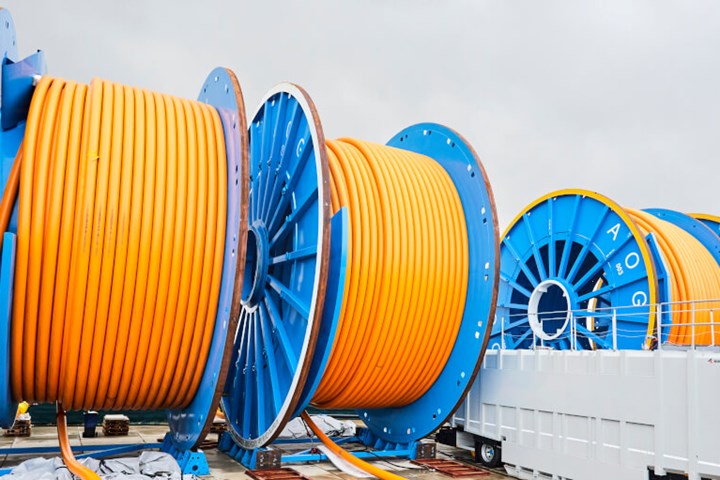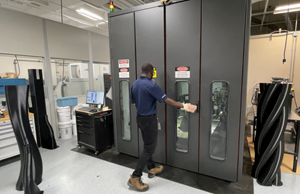Strohm thermoplastic composite pipes receive DNV certification, reported to have low carbon footprint
Strohm and Evonik’s carbon fiber/PA12 pipes are now fit to use for hydrocarbons transport. A lifecycle report also found the TCP pipes to have a 60% lower carbon footprint than an equivalent carbon steel pipeline.

Photo Credit: Strohm
Strohm (IJmuiden, Netherlands) and Evonik (Essen, Germany) have been awarded the full certification from DNV (Høvik, Norway), attesting that the unidirectional (UD) carbon fiber PA12 tape “Vestape PA12-CF” (PA12) used for Strohm’s 100% recyclable thermoplastic composite pipes (TCP) is fit to use for dynamic sweet and sour hydrocarbons, water and gas injection applications according to DNV-ST-F119.
The two companies, in partnership with the Netherlands Aerospace Centre (NLR, Amsterdam, Netherlands), have reportedly led the way in the development, qualification and supply of PA12 for TCP applications following an intensive investment and testing program over the past five years, in which the NLR provided the main composite testing facilities. The program served to develop a fundamental understanding of the material to demonstrate the lifetime performance of a product operating in a challenging chemical, thermal and mechanical environment.
During the program, Rens Ubels, principal project engineer at NLR points to one test, where the carbon fiber-reinforced PA12 specimens were tested in-situ in Norsok fluid at elevated temperatures, something that proved challenging. “We successfully designed and built dedicated fatigue and stress rupture setups to be able to meet the test specifications and the safety and health regulations,” Ubels adds.
PA12 is a fully non-metallic, corrosion-resistant solution. Reinforced with carbon fibers, it is said to be exceptionally resistant to fatigue-based failures, marking it for any dynamic application, from jumpers to flowlines and risers, including sweet and sour hydrocarbon, water and gas service. Moreover, the carbon fiber’s high stiffness, paired with the load transfer capability of PA12 as a matrix, also enables it for deepwater service and operating pressures up to 700 bar and temperatures up to 80°C. The material has been qualified for a lifetime of up to 30 years. Further expansion of the scope will include hydrogen and carbon capture use and storage.
“Developing a material class for disruptive technologies is always challenging. PA12 for Strohm’s TCP applications was no exception,” notes Carsten Schuett, industrial and energy technology leader at Evonik. “The full application of the DNV’s standard’s approach to qualify the material has only added to the complexity but, with the help of our partners, we finally succeeded in characterizing the material in unprecedented detail and unlocked its full potential. The resulting dataset can be used generically, removing the need for material qualification in further projects which further enables us to use it for energy transition applications.”
A whitepaper discussing the qualification can be found here.
Eco-friendly thermoplastic pipes
DNV, Strohm and the Non-Metallic Innovation Centre (NIC, Cambridge, U.K.) have also launched a report comparing the lifecycle carbon footprint of externally coated carbon steel pipe and TCP, finding that the latter has a significantly lower carbon footprint — between 30-60% — than an equivalent carbon steel pipeline solution.
The report outlines the results from a joint industry project (JIP) between the three companies focusing on the lifecycle of a 22-kilometer (14-mile) pipeline transporting produced water for injection in a field outside Angola in western Africa, with an operating lifetime of 20 years.
The companies considered all steps of the lifecycle carbon footprint which is a measure of the direct and indirect greenhouse gas (GHG) emissions associated with all activities in the product's life cycle, from material extraction and production to the end-of-life (EOL) stage of the pipelines.
According to Caroline Justet, business growth executive for energy in transition at Strohm, the study takes a significant step towards establishing TCP as a suitable alternative to steel in offshore applications.
Related Content
The AAMMC Tech Hub: Ramping U.S. production of large thermoplastic composite aerostructures
CW talks with Syensqo, Spirit AeroSystems and other consortia members about current funding, specification of the next world’s largest press, organizational structure and projects to support U.S. companies in the race to deliver >40,000 sustainable and efficient aircraft over the next 20 years.
Read MoreMFFD longitudinal seams welded, world's largest CFRTP fuselage successfully completed
Fraunhofer IFAM and partners have completed left and right welds connecting the upper and lower fuselage halves and sent the 8×4-meter full-scale section to ZAL for integration with a cabin crown module and testing.
Read MorePlant tour: Collins Aerospace, Riverside, Calif., U.S. and Almere, Netherlands
Composite Tier 1’s long history, acquisition of stamped parts pioneer Dutch Thermoplastic Components, advances roadmap for growth in thermoplastic composite parts.
Read MoreEaton developing carbon-reinforced PEKK to replace aluminum in aircraft air ducts
3D printable material will meet ESD, flammability and other requirements to allow for flexible manufacturing of ducts, without tooling needed today.
Read MoreRead Next
Scaling up, optimizing the flax fiber composite camper
Greenlander’s Sherpa RV cab, which is largely constructed from flax fiber/bio-epoxy sandwich panels, nears commercial production readiness and next-generation scale-up.
Read MoreCeramic matrix composites: Faster, cheaper, higher temperature
New players proliferate, increasing CMC materials and manufacturing capacity, novel processes and automation to meet demand for higher part volumes and performance.
Read MoreNext-gen fan blades: Hybrid twin RTM, printed sensors, laser shock disassembly
MORPHO project demonstrates blade with 20% faster RTM cure cycle, uses AI-based monitoring for improved maintenance/life cycle management and proves laser shock disassembly for recycling.
Read More


























